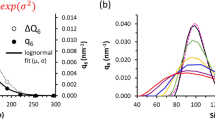Abstract
A powerful but still easy to use technique is proposed for the processing and analysis of dynamic mechanical data. The experimentally determined dynamic moduli,G′(ω) andG″(ω), are converted into a discrete relaxation modulusG(t) and a discrete creep complianceJ(t). The discrete spectra are valid in a time window which corresponds to the frequency window of the input data. A nonlinear regression simultaneously adjust the parametersg i ,λ i ,i = 1,2, ⋯N, of the discrete spectrum to obtain a best fit ofG′, G″, and it was found to be essential that bothg i andλ i are freely adjustable. The number of relaxation times,N, adjusts during the iterative calculations depending on the needs for avoiding ill-posedness and for improved fit. The solution is insensitive to the choice of initial valuesg i,0,λ i,0,N 0. The numerical program was calibrated with the gel equation which gives analytical expressions both in the time and the frequency domain. The sensitivity of the solution was tested with model data which, by definition, are free of experimental error. From the relaxation time spectrum, a corresponding discrete set of parametersJ 0,η, J d,i andΛ i of the creep complianceJ(t) can then readily be calculated using the Laplace transform.
Similar content being viewed by others
References
Tanner RI (1968) J Appl Polym Sci 12:1649
Friedrich G, Hoffmann B (1983) Rheol Acta 22:425
Ferry JD (1980) Viscoelastic Properties of Polymers. Wiley, New York
Gross B (1953) Mathematical Structure of the Theories of Viscoelasticity, Hermann & Cie., Paris
Staverman AJ, Schwarzl F (1956) In: Die Physik der Hochpolymeren, Vol 4. Springer-Verlag, Berlin
Baumgaertel M, Winter HH (1989) Proceedings Antec 89
Friedrich J, Blumen A (1985) Phys Rev B. Rapid Com 32(2):1434
Winter HH (1989) “Gel Point” In: Kroshwitz J, Bikales N (ed) Encycl Polym Sci Eng. Supplement (1989) p 343
Heindl W, Giesekus H (1972) Rheol Acta 11:152
Larson RG (1985) Rheol Acta 24:327
Laun HM (1978) Rheol Acta 17:1
Soskey PR, Winter HH (1984) J Rheol 28(5):625
Honerkamp J, Weese J (1989) Macromolecules. In press
Leaderman H (1958) Rheology, Theory and Applications, Vol 2. Academic Press, New York
Giesekus H (1970) Lecture notes
Schausberger A, Schindlauer G, Janeschitz-Kriegl H (1985) Rheol Acta 24:220
Schausberger A (1986) Rheol Acta 25(6):595
Chambon F, Winter HH (1985) Polymer Bulletin 13:499
Kamath VM, Mackley MR (1989) J Non-Newtonian Fluid Mech 32:119
Author information
Authors and Affiliations
Additional information
This paper is dedicated to Professor Hanswalter Giesekus on the occasion of his retirement as Editor of Rheologica Acta.
Rights and permissions
About this article
Cite this article
Baumgaertel, M., Winter, H.H. Determination of discrete relaxation and retardation time spectra from dynamic mechanical data. Rheol Acta 28, 511–519 (1989). https://doi.org/10.1007/BF01332922
Received:
Issue Date:
DOI: https://doi.org/10.1007/BF01332922




